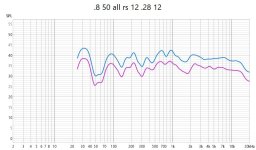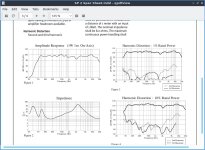I have taken several plots of my Purifi /Satori beryllium speakers, detailed in the thread 'Possible MTM Fun Project'.
I used an Omnicron USB mic and REW on a laptop. These have been useful in voicing the speakers, but I might like some advice as I'm not familiar with interpreting the plots or using REW in other ways.
First, here is a plot where it is now. Here are details of the crossover.
Bass: 2nd order 0.8mH, 50uF, very small notch at 3.5kHz; the 0.8 set by trial and error to give a reasonable bass level.
Treble: 3rd order 12uF, 0.28mH, 12uf; dropper 2 ohm/12ohm, with added 6ohm between crossover and speaker.
Note that the green line is the current state with 0.28mH; red is with 0.23mH.
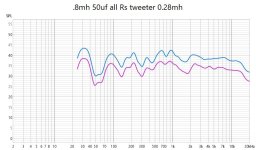
I am not sure how good this FR is. Divisions are 1dB so it is fairly flat, but I don't know if this is 'acceptable'.
So I compared with other speakers, below.
Monitor Audio (old), stand mount bass reflex. I don't know the model number.
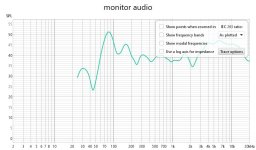
My SEAS ER18/27TDFC MTM:
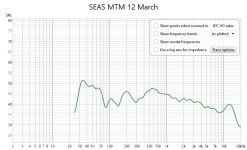
The Monitor Audio sounds reasonable, the SEAS MTM sounds very good even though its FR does not look so good.
To me, the new Purifi/Be MTM plot looks the best, as with 1dB per division the variation is not that much. Am I kidding myself????
There is an issue, which Mark (who made a good TM with these drivers) points out; there is a dip at 1800Hz (xover frequency) and a peak just below.
I don't think I hear a problem, but then I don't know what to listen for.
I improved the dip somewhat by increasing the tweeter inductor from .23 to.28mH, but it also raised the peak somewhat.
So I am wondering if I should continue to try to improve the dip, or whether such a dip is minor, of a value to be expected and nothing to worry about.
If it is a case of accepting the dip (the sound is good), I will revisit the 0.23mH, as the peak below 1800Hz looks to be less.
Any advice welcomed.
I used an Omnicron USB mic and REW on a laptop. These have been useful in voicing the speakers, but I might like some advice as I'm not familiar with interpreting the plots or using REW in other ways.
First, here is a plot where it is now. Here are details of the crossover.
Bass: 2nd order 0.8mH, 50uF, very small notch at 3.5kHz; the 0.8 set by trial and error to give a reasonable bass level.
Treble: 3rd order 12uF, 0.28mH, 12uf; dropper 2 ohm/12ohm, with added 6ohm between crossover and speaker.
Note that the green line is the current state with 0.28mH; red is with 0.23mH.

I am not sure how good this FR is. Divisions are 1dB so it is fairly flat, but I don't know if this is 'acceptable'.
So I compared with other speakers, below.
Monitor Audio (old), stand mount bass reflex. I don't know the model number.

My SEAS ER18/27TDFC MTM:

The Monitor Audio sounds reasonable, the SEAS MTM sounds very good even though its FR does not look so good.
To me, the new Purifi/Be MTM plot looks the best, as with 1dB per division the variation is not that much. Am I kidding myself????
There is an issue, which Mark (who made a good TM with these drivers) points out; there is a dip at 1800Hz (xover frequency) and a peak just below.
I don't think I hear a problem, but then I don't know what to listen for.
I improved the dip somewhat by increasing the tweeter inductor from .23 to.28mH, but it also raised the peak somewhat.
So I am wondering if I should continue to try to improve the dip, or whether such a dip is minor, of a value to be expected and nothing to worry about.
If it is a case of accepting the dip (the sound is good), I will revisit the 0.23mH, as the peak below 1800Hz looks to be less.
Any advice welcomed.
Attachments
Given what I see in your plots, if taken indoors as a single measurement, the frequency response is being influenced by room effects. That makes it harder to judge fine details between various designs.
Quasi-anechoic methods are typically used to eliminate everything but the first sound arrival from the speaker you are measuring. This inherently limits the lowest frequency that can be measured, but greatly improves the accuracy of the measurement if you want to see what the speaker is doing on its own.
In-room, long-windowed measurements can still be useful for other purposes though.
Quasi-anechoic methods are typically used to eliminate everything but the first sound arrival from the speaker you are measuring. This inherently limits the lowest frequency that can be measured, but greatly improves the accuracy of the measurement if you want to see what the speaker is doing on its own.
In-room, long-windowed measurements can still be useful for other purposes though.
Sweep from 100hz and up, and use gated settings to eliminate reflections. Then show your graph from 300hz and up. (approx)
This will stretch the graph out, so it will look more "normal".
This will stretch the graph out, so it will look more "normal".
Those are really bad responses, even above 100 hz. minus 5 db gaps at 150 hz & 300 hz? What gate did you use on the REW? If room response, okay, but learn to use REW the right way.
Here is a anechoic +- 3 db plot from a commercial speaker I have in my music room. These are the best speakers I have heard in my flyover metroplex.
Here is a anechoic +- 3 db plot from a commercial speaker I have in my music room. These are the best speakers I have heard in my flyover metroplex.
Attachments
try to measure outside and from different angles
if any peaks and dips show up from all the angles indoors and outdoors then it's a problem with the speaker
if you can't go outside just go to another room or to different spot in the room etc
that is some of these effects may be due to mic position, speaker position, angle etc. but others may be legit problems
by randomizing test conditions you will be able to tell which deviations from flat are random and which ones are not
if any peaks and dips show up from all the angles indoors and outdoors then it's a problem with the speaker
if you can't go outside just go to another room or to different spot in the room etc
that is some of these effects may be due to mic position, speaker position, angle etc. but others may be legit problems
by randomizing test conditions you will be able to tell which deviations from flat are random and which ones are not
Thanks folks, I admit I don't know how to use REW properly and I will learn abut gating. Hey, I'm new to all this. 🙂
Indianajo, your words and pictures are most useful and are noted; the plot gives me an idea of what to aim for.
I had disregarded the odd result below 100Hz as being room related and (forgive me if I'm wrong) not untypical; as the bass seems good quality and about the right quantity, I have not been too concerned here.
The dips at about 130 and 300Hz I did notice, but a rough mental calculation suggested wavelengths about 7 feet and 15 feet, so though I don't know enough to know how the dip results, with a ceiling height of 7.5 ft and room depth 14ft this seems quite a coincidence.
I also note that your plot shows a dip of about 5dB at 2k Hz, which compares with my dip of 5dB at 1800Hz, and that in your case it does not seem to spoil the sound.
Other than this dip, your FR is within a range of 4dB; mine is within a 6dB range other than the 1800Hz dip and the above mentioned dips which may be room related - and OK, should not be ignored without investigation.
So I have a bit more to do, but I venture to suggest I'm not too far off, I know how to improve my work, and I have a target to aim for.
I thank you all for this.
Even with issues, the speakers do sound very good.
Indianajo, your words and pictures are most useful and are noted; the plot gives me an idea of what to aim for.
I had disregarded the odd result below 100Hz as being room related and (forgive me if I'm wrong) not untypical; as the bass seems good quality and about the right quantity, I have not been too concerned here.
The dips at about 130 and 300Hz I did notice, but a rough mental calculation suggested wavelengths about 7 feet and 15 feet, so though I don't know enough to know how the dip results, with a ceiling height of 7.5 ft and room depth 14ft this seems quite a coincidence.
I also note that your plot shows a dip of about 5dB at 2k Hz, which compares with my dip of 5dB at 1800Hz, and that in your case it does not seem to spoil the sound.
Other than this dip, your FR is within a range of 4dB; mine is within a 6dB range other than the 1800Hz dip and the above mentioned dips which may be room related - and OK, should not be ignored without investigation.
So I have a bit more to do, but I venture to suggest I'm not too far off, I know how to improve my work, and I have a target to aim for.
I thank you all for this.
Even with issues, the speakers do sound very good.
Search for this (audio xpress):
Testing Loudspeakers: Which Measurements Matter, Part1
Testing Loudspeakers: Which Measurements Matter, Part2
And this:
5th Elements guide to making useful loudspeaker measurements (should direct you to diyAudio pdf)
Testing Loudspeakers: Which Measurements Matter, Part1
Testing Loudspeakers: Which Measurements Matter, Part2
And this:
5th Elements guide to making useful loudspeaker measurements (should direct you to diyAudio pdf)
Thanks folks, this is all most useful. I have tried gating and moving the speakers, all of which were useful.
The fundamental problem remains, the room is a store/workshop with lots of stuff; I'm very much OK (can do sailing, DIY etc) but have to be careful over heavy lifting, so I can't get the speakers outside or improve the room.
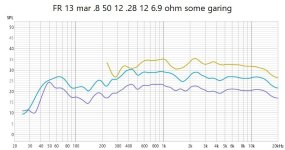
The above shows gating at 3.3mS and also with a large number to get the bass. I know I'm not using REW properly but don't kick me too hard as I'm definitely getting useful results which correlate with listening, so voicing is going well. I will discuss this more in my thread about my fun MTM speakers.
Indianajo, I know you are right, even so I guess some irregularities are due to the poor environment. When I plot your sample of a good speaker, and my FR (the lower one) to the same scale, mine is definitely not as good; it needs some work, but it doesn't look too awful to me.
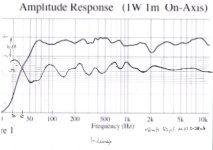
So I know I'm not right with REW for good reasons, but getting useful results, I note all that is said, I have learnt masses; so I'll say thanks and I guess this closes this discussion.
The fundamental problem remains, the room is a store/workshop with lots of stuff; I'm very much OK (can do sailing, DIY etc) but have to be careful over heavy lifting, so I can't get the speakers outside or improve the room.

The above shows gating at 3.3mS and also with a large number to get the bass. I know I'm not using REW properly but don't kick me too hard as I'm definitely getting useful results which correlate with listening, so voicing is going well. I will discuss this more in my thread about my fun MTM speakers.
Indianajo, I know you are right, even so I guess some irregularities are due to the poor environment. When I plot your sample of a good speaker, and my FR (the lower one) to the same scale, mine is definitely not as good; it needs some work, but it doesn't look too awful to me.

So I know I'm not right with REW for good reasons, but getting useful results, I note all that is said, I have learnt masses; so I'll say thanks and I guess this closes this discussion.
- Home
- Loudspeakers
- Multi-Way
- Advice welcomed about interpreting Frequency Response plots
